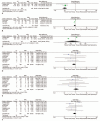Focal therapy versus robot-assisted partial nephrectomy in the management of clinical T1 renal masses: A systematic review and meta-analysis
- PMID: 30407321
- PMCID: PMC6250551
- DOI: 10.1097/MD.0000000000013102
Focal therapy versus robot-assisted partial nephrectomy in the management of clinical T1 renal masses: A systematic review and meta-analysis
Abstract
Background: Robot-assisted partial nephrectomy (RPN) and focal therapy (FT) have both been successfully employed in the management of small renal masses. However, despite this being the era of minimally invasive surgery, few comparative studies exist on RPN and FT. The aim of our study is to review perioperative, renal functional and oncologic outcomes of FT and RPN in cT1 renal masses.
Methods: Literature published in Medline, EMBASE, and Cochrane Library databases up to April 22, 2018, was systematically searched. We included literature comparing outcomes of FT (radiofrequency ablation, cryoablation, microwave ablation, and irreversible electroporation) and RPN. Studies that reported only on laparoscopic partial nephrectomy or open partial nephrectomy, and review articles, editorials, letters, or cost analyses were excluded. In total, data from 1166 patients were included.
Results: From 858 total articles, 7 nonrandomized, observational studies were included. Compared with RPN, FT was associated with a significantly lower decrease of estimated glomerular filtration rate (weighted mean difference [WMD] -8.06 mL/min/1.73 m; confidence interval [CI] -15.85 to -0.26; P = .04), and lower estimated blood loss (WMD -49.61 mL; CI -60.78 to -38.45; P < .001). However, patients who underwent FT had a significantly increased risk of local recurrence (risk ratio [RR] 9.89; CI 4.24-23.04; P < .001) and distant metastasis (RR 6.42; CI 1.70-24.33; P = .006). However, operative times, lengths of stay, and complication rates were revealed to be similar between FT and RPN.
Conclusion: RPN has a substantial advantage in preventing cancer recurrence. However, in the era of minimally invasive surgery, FT has advantages in renal function preservation and less bleeding. Long-term follow-up for survival rates and comparative analysis of microwave ablation and irreversible electroporation are needed to extend FT for patients with significant morbidities and for those who need sufficient renal function preservation with minimal bleeding.
Conflict of interest statement
The authors have no conflicts of interest to disclose.
Figures




Similar articles
-
Systematic Review and Meta-Analysis of Comparative Studies Reporting Perioperative Outcomes of Robot-Assisted Partial Nephrectomy Versus Open Partial Nephrectomy.J Endourol. 2017 Sep;31(9):893-909. doi: 10.1089/end.2016.0351. Epub 2017 Mar 29. J Endourol. 2017. PMID: 27305835
-
Partial Nephrectomy Versus Radical Nephrectomy for Clinical T1b and T2 Renal Tumors: A Systematic Review and Meta-analysis of Comparative Studies.Eur Urol. 2017 Apr;71(4):606-617. doi: 10.1016/j.eururo.2016.08.060. Epub 2016 Sep 7. Eur Urol. 2017. PMID: 27614693
-
Laparoscopic renal cryoablation versus laparoscopic partial nephrectomy for the treatment of small renal masses: a systematic review and meta-analysis of comparative studies.J Laparoendosc Adv Surg Tech A. 2014 Jun;24(6):403-10. doi: 10.1089/lap.2013.0550. J Laparoendosc Adv Surg Tech A. 2014. PMID: 24914926
-
Systematic review and meta-analysis of perioperative and oncologic outcomes of laparoscopic cryoablation versus laparoscopic partial nephrectomy for the treatment of small renal tumors.J Urol. 2014 May;191(5):1209-17. doi: 10.1016/j.juro.2013.11.006. Epub 2013 Nov 11. J Urol. 2014. PMID: 24231845
-
Percutaneous ablation versus robotic‑assisted partial nephrectomy for cT1 renal cell carcinoma: an evidence-based analysis of comparative outcomes.J Robot Surg. 2024 Jul 30;18(1):301. doi: 10.1007/s11701-024-02037-y. J Robot Surg. 2024. PMID: 39078530
Cited by
-
Long-term outcomes of cryoablation for biopsy-proven T1 stage renal cell carcinoma.World J Surg Oncol. 2022 Sep 6;20(1):284. doi: 10.1186/s12957-022-02752-6. World J Surg Oncol. 2022. PMID: 36064369 Free PMC article.
-
Prediction of Fuhrman pathological grade of renal clear cell carcinoma based on CT texture analysis.Am J Clin Exp Urol. 2024 Feb 15;12(1):28-35. eCollection 2024. Am J Clin Exp Urol. 2024. PMID: 38500865 Free PMC article.
-
Perioperative, functional and oncologic outcomes of percutaneous ablation versus minimally invasive partial nephrectomy for clinical T1 renal tumors: outcomes from a pooled analysis.J Robot Surg. 2024 Aug 6;18(1):306. doi: 10.1007/s11701-024-02052-z. J Robot Surg. 2024. PMID: 39105944
-
Perioperative, functional, and oncological outcomes after cryoablation or partial nephrectomy for small renal masses in solitary kidneys: a systematic review and meta-analysis.BMC Urol. 2024 Jan 24;24(1):19. doi: 10.1186/s12894-024-01406-x. BMC Urol. 2024. PMID: 38268005 Free PMC article.
-
Comparison of Robot-Assisted Laparoscopic Partial Nephrectomy with Laparoscopic Cryoablation in the Treatment of Localised Renal Tumours: A Propensity Score-Matched Comparison of Long-Term Outcomes.Diagnostics (Basel). 2021 Apr 23;11(5):759. doi: 10.3390/diagnostics11050759. Diagnostics (Basel). 2021. PMID: 33922727 Free PMC article.
References
-
- Campbell SC, Novick AC, Belldegrun A, et al. Guideline for management of the clinical T1 renal mass. J Urol 2009;182:1271–9. - PubMed
-
- Ficarra V, Novara G, Secco S, et al. Preoperative aspects and dimensions used for an anatomical (PADUA) classification of renal tumours in patients who are candidates for nephron-sparing surgery. Eur Urol 2009;56:786–93. - PubMed
-
- Choi JE, You JH, Kim DK, et al. Comparison of perioperative outcomes between robotic and laparoscopic partial nephrectomy: a systematic review and meta-analysis. Eur Urol 2015;67:891–901. - PubMed
-
- Johnson BA, Cadeddu JA. Current opinion in urology 2017: focal therapy of small renal lesions. Curr Opin Urol 2018;28:166–71. - PubMed
Publication types
MeSH terms
LinkOut - more resources
Full Text Sources
Medical
Miscellaneous

